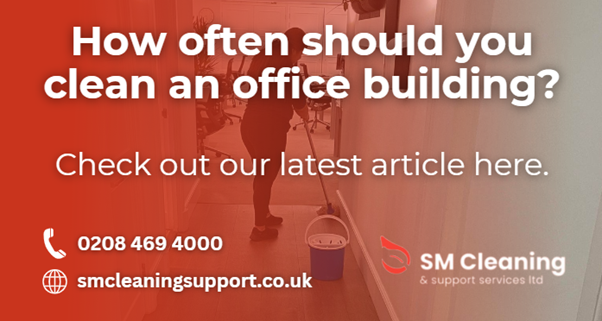A clean and organised office is not just aesthetically pleasing; it also contributes to a healthier work environment and increased productivity among employees. However, determining the optimal frequency for cleaning an office building can be a challenge. In this article, we will explore the factors that influence cleaning frequency and provide practical guidelines for maintaining a spotless and conducive workspace.
Daily Cleaning Essentials
Certain cleaning tasks should be performed on a daily basis to ensure a consistently clean and hygienic office environment. These include:
- Surface Cleaning: Wiping down desks, tables, and countertops to remove dust and prevent the spread of germs.
- Waste Disposal: Emptying waste bins and replacing liners to maintain a tidy and odour-free workspace.
- Floor Maintenance: Vacuuming or sweeping floors to eliminate dirt and debris.
Daily cleaning is crucial for high-traffic areas and shared spaces, such as meeting rooms and kitchens, where germs and clutter can accumulate quickly.
Regular Weekly Cleaning
In addition to daily cleaning tasks, certain areas and items benefit from more thorough attention on a weekly basis. Consider incorporating the following into your weekly cleaning routine:
- Floor Cleaning: Mopping or steam-cleaning floors to remove stains and maintain a polished appearance.
- Dusting: Addressing less frequently used surfaces, such as shelves, light fixtures, and electronic equipment, to prevent the build-up of dust.
- Window Cleaning: Wiping down windows and glass surfaces to maintain a clear view and let in natural light.
Weekly cleaning tasks contribute to the overall maintenance of the office space, keeping it fresh and inviting.
Monthly Deep Cleaning
To maintain a truly pristine office environment, a deeper level of cleaning should be performed on a monthly basis. This may include tasks such as:
- Carpet Cleaning: Steam-cleaning carpets to remove deep-seated dirt and stains.
- Upholstery Cleaning: Cleaning and sanitising office furniture, including chairs and sofas.
- Air Vent Cleaning: Removing dust and debris from air vents to improve indoor air quality.
- Detailed Appliance Cleaning: Cleaning out refrigerators, microwaves, and other communal appliances to prevent the growth of bacteria.
Monthly deep cleaning helps address areas that may be overlooked during daily and weekly routines, promoting a healthier and more comfortable workspace.
Seasonal and Specialised Cleaning
Certain cleaning tasks are best suited for specific seasons or occasions. For example:
- Window Washing: Exterior window cleaning may be scheduled seasonally to ensure a clear view and maximise natural light.
- Carpet and Rug Maintenance: Seasonal deep cleaning for carpets and rugs can help extend their lifespan.
- Outdoor Space Cleaning: If your office has an outdoor area, regular cleaning of pathways, seating areas, and exterior surfaces may be necessary.
Specialised cleaning tasks should be tailored to the unique needs of your office space and the nature of your business.
Assessing Unique Needs
The frequency of office cleaning should be tailored to the unique needs of each workspace. Factors such as office size, industry, the number of employees, and the type of business operations all influence the optimal cleaning schedule. A busy office with high foot traffic may require more frequent cleaning than a smaller, quieter space.
Bottom Line
Maintaining a clean office is not just about appearances; it directly impacts the well-being and productivity of your team. SM Cleaning understands the importance of a pristine workspace, offering a range of professional commercial cleaning services in London. Whether it’s daily, weekly, or specialised cleaning, their dedicated teams ensure a high-quality, environmentally conscious approach. As we’ve explored how often you should clean an office building, trust SM Cleaning to provide a tailored solution for your specific needs.




